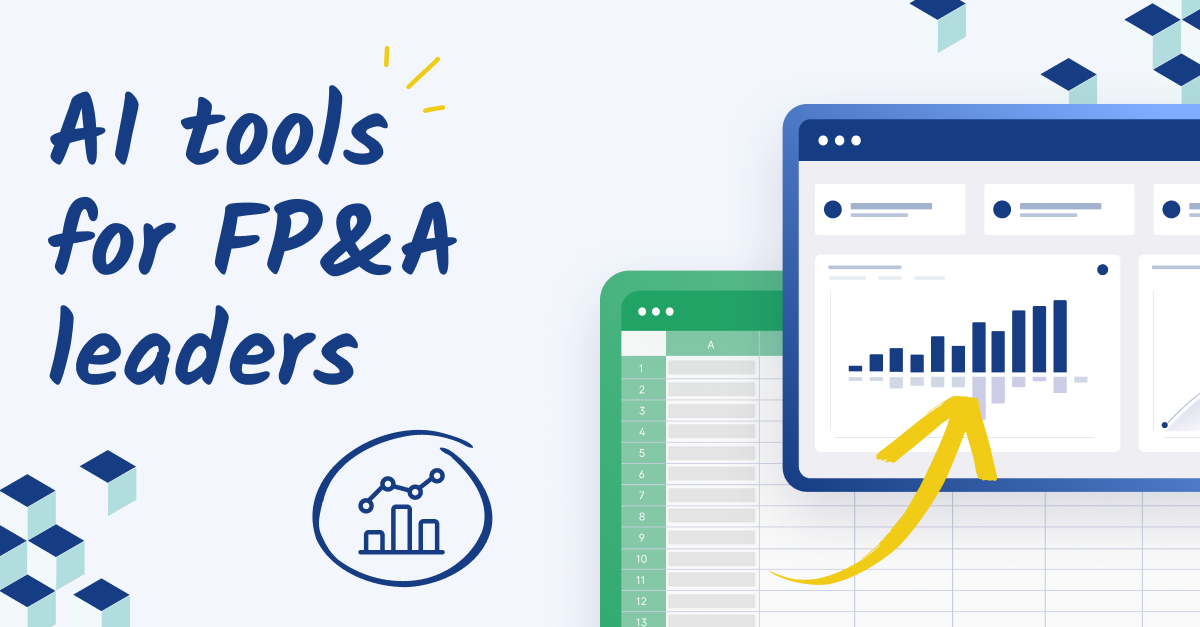Making an impact: Crucial skills for strategic finance leaders
FP&A professionals are experiencing a major shift in their roles. In the past, FP&A teams were primarily responsible for budgeting, forecasting, and analyzing variances. But now, they're expected to play a key role in strategic finance, driving long-term financial health and supporting big decisions.
To understand why learning these new skills is so important, let's dive into how they impact both your career and your organization.
The evolving role of FP&A leaders
FP&A leaders today are much more than number crunchers. They are strategic advisors who need to understand the business deeply, keep up with industry trends, and consider external economic factors.
Your insights are critical for shaping your company's strategic direction. Moving beyond traditional roles means you can influence key business decisions and ensure that financial strategies align with the company's goals.
Competitive advantage
Standing out in a competitive job market is crucial. Companies are looking for FP&A leaders who can provide strategic input, and those who master advanced skills in data analytics, business partnering, and scenario planning are invaluable.
These skills allow you to offer more nuanced and forward-thinking insights, giving your organization an edge. For you, mastering these skills can lead to faster career growth and recognition as a thought leader.
Impact on business success
Shifting from traditional FP&A roles to strategic finance involves a change in mindset. Instead of just reporting past performance, you need to predict future trends and advise on proactive measures. This shift can significantly impact business success in several ways:
- Better decision-making: Advanced data analytics and visualization help you provide executives with clear, actionable insights.
- Strategic business partnering: Collaborating effectively with other departments ensures financial strategies support broader business goals.
- Robust scenario planning: Preparing for various scenarios helps the organization navigate uncertainties and mitigate risks.
- Compelling financial narratives: Crafting engaging financial stories secures stakeholder buy-in for strategic initiatives, driving alignment and support.
- Adaptability and innovation: FP&A leaders must pivot quickly in response to market shifts, regulatory changes, or internal developments. Mastering skills like predictive analytics and change management enables you to lead your team through transformations, implement innovative solutions, and stay ahead of trends.
Career growth
Pursuing these new skills is directly tied to your career growth. Investing in continuous learning shows your commitment to professional development, making you a more attractive candidate for senior leadership roles. Enhancing your skill set positions you for opportunities such as CFO or other executive positions, where you can have an even greater impact on your organization's strategic direction.
As you embrace your evolving role, these skills will empower you to lead with confidence, influence critical business decisions, and achieve your career goals in strategic finance.

Top 5 skills to excel as an FP&A leader
1. Advanced data analytics and visualization
Data is the backbone of informed decision-making. As an FP&A leader, you need to go beyond basic data analysis. Advanced analytics involves identifying patterns, trends, and anomalies that can inform strategic decisions. This deeper level of analysis helps you anticipate challenges, uncover opportunities, and make recommendations that align with the company’s long-term goals.
Transforming complex data into actionable insights is essential for FP&A leaders. Advanced data analytics and visualization skills enable you to make sense of vast amounts of information and present it in a clear, impactful way—crucial for leveraging data to drive strategic decisions.
To excel in advanced data analytics and visualization, it's important to have the right software. While traditional spreadsheet software can handle basic tasks, modern FP&A software solutions offer advanced features that can elevate your analysis.
Here are some key tools you should consider:
- Power BI and Tableau: These industry-leading tools for data visualization help create interactive and visually appealing dashboards that make complex data more accessible.
- Cube Software: Designed specifically for FP&A, Cube integrates data from various sources, enabling you to perform comprehensive analyses without needing to code. Its user-friendly interface allows for powerful data manipulation and visualization.
Advanced data analytics can transform how FP&A leaders contribute to strategic finance. For example, imagine you're tasked with optimizing the company's budget. With advanced analytics, you can identify which areas of spending have the highest ROI and recommend reallocating resources to maximize financial performance. This proactive approach positions you as a strategic advisor who drives business success.
2. Strategic business partnering
As an FP&A leader, moving beyond traditional finance roles to becoming a strategic advisor is crucial. Strategic business partnering involves collaborating closely with other departments to align financial strategies with broader business goals. This skill requires strong communication, relationship-building, and a deep understanding of the business.
FP&A leaders who excel as strategic business partners are advisors who help shape the company's strategic direction. This involves understanding the goals and challenges of different departments and ensuring that financial strategies support these objectives. By fostering close relationships with key stakeholders, you can influence decision-making and drive better business outcomes.
Techniques for effective communication and collaboration
Effective communication is at the heart of strategic business partnering. Here are some techniques to enhance your collaboration with other departments:
- Active listening: Pay close attention to the concerns and goals of your colleagues in other departments. Understanding their perspective helps you provide more relevant and impactful financial advice.
- Tailored communication: Adapt your communication style to suit your audience. Use straightforward language when discussing financial concepts with non-financial colleagues.
- Regular check-ins: Establish regular meetings with key stakeholders to discuss financial performance and strategic initiatives. This promotes ongoing collaboration and ensures alignment.
- Cross-functional teams: Participate in or lead cross-functional teams that tackle strategic projects. This builds stronger relationships and a deeper understanding of the business.
Examples of strategic initiatives led by FP&A leaders
FP&A leaders who excel in strategic business partnering can drive significant initiatives within their organizations. For instance, consider a scenario where the marketing department plans to launch a new product. As a strategic partner, you can provide insights into pricing strategies, budget allocation, and potential financial risks. Your input ensures that the product launch aligns with the company’s financial goals and maximizes profitability.
Another example involves working with the operations team to improve efficiency. By analyzing operational data, you can identify cost-saving opportunities and recommend process improvements. Your strategic insights help the company operate more efficiently and improve its bottom line.
Developing a business partner mindset
To become an effective strategic business partner, it's essential to adopt a business partner mindset. This involves seeing yourself as an integral part of the broader business, not just the finance department. Here are some tips:
- Understand the business: Take the time to learn about the operations, challenges, and goals of different departments. This knowledge enables you to provide more relevant and impactful financial advice.
- Be proactive: Don't wait for other departments to come to you with questions. Actively seek out opportunities to collaborate and offer your insights.
- Build trust: Establish yourself as a reliable and approachable advisor. Consistently provide valuable insights and support to build trust with your colleagues.
3. Scenario planning and predictive analytics
As an FP&A leader, preparing for various business scenarios and uncertainties is essential. Scenario planning and predictive analytics equip you with the tools to anticipate potential outcomes and devise strategies to navigate them effectively. These skills help you provide forward-looking insights that guide your organization through both opportunities and challenges.
Scenario planning involves creating detailed and plausible views of possible future conditions. This proactive approach allows you to prepare for a range of outcomes, ensuring that your organization can respond swiftly and effectively to changes in the business environment. By considering different scenarios, you can develop contingency plans that mitigate risks and capitalize on opportunities.
Predictive analytics uses historical data, statistical algorithms, and machine learning techniques to identify the likelihood of future outcomes. This skill is invaluable for FP&A leaders who need to forecast financial performance, market trends, and other critical variables. Predictive analytics helps you move from reactive to proactive decision-making, providing a competitive edge in strategic planning.
Tools and methodologies for scenario planning
To excel in scenario planning and predictive analytics, familiarize yourself with the following tools and methodologies:
- Data visualization tools: Software like Power BI and Tableau can help you create visual representations of different scenarios, making it easier to communicate your insights to stakeholders.
- Advanced FP&A software: Modern FP&A solutions often include built-in capabilities for scenario planning and predictive analytics, allowing you to perform complex analyses without needing extensive technical expertise.
- Statistical models: Understanding basic statistical models and forecasting techniques can enhance your ability to predict future outcomes and assess the likelihood of different scenarios.
Developing a scenario planning mindset
To effectively integrate scenario planning and predictive analytics into your role, adopt a proactive and analytical mindset:
- Embrace uncertainty: Accept that the future is unpredictable and focus on preparing for a range of possibilities rather than a single outcome.
- Stay informed: Keep up with industry trends, market developments, and technological advancements to ensure your scenarios are grounded in current realities.
- Collaborate: Work closely with other departments to gather diverse perspectives and insights, enriching your scenario planning process.

4. Financial storytelling and narrative building
Crafting compelling financial stories is a vital skill for FP&A leaders who want to influence stakeholders and drive strategic initiatives. Financial storytelling and narrative building involve presenting financial data in a clear, engaging way that resonates with your audience and helps them understand the broader business context.
Numbers alone often fail to convey the full picture. Effective financial storytelling bridges the gap between data and decision-making by weaving a narrative that highlights key insights and their implications for the business. This helps stakeholders grasp the significance of financial performance and makes complex information more accessible and actionable.
Techniques for presenting financial data
To become a master of financial storytelling, consider these techniques:
- Contextualize the data: Always provide context for your numbers. Explain why the data is important, what it means for the business, and how it aligns with strategic goals.
- Use visuals effectively: Visual aids like charts, graphs, and dashboards can make data more digestible. Tools like Cube, Power BI, and Tableau are excellent for creating impactful visualizations.
- Focus on key messages: Highlight the most important takeaways and avoid overwhelming your audience with too much detail. Stick to the points that matter most to your audience.
- Tell a story: Structure your presentation like a narrative. Start with a clear introduction, build up to the key insights, and conclude with actionable recommendations.
A well-crafted narrative not only makes financial data more understandable but also more persuasive. By framing your analysis within a story, you can better illustrate how financial performance impacts the broader business strategy.
Consider a scenario where you're presenting quarterly financial results to the board. Instead of just listing numbers, you could frame the story around the company’s strategic goals. For example, “In Q1, we focused on expanding our market reach, which resulted in a 15% increase in revenue from new customers. This growth supports our long-term strategy of diversifying our customer base and reducing dependency on our top accounts.”
Another example involves preparing a financial forecast. Instead of simply showing projections, explain the assumptions behind the numbers and their strategic implications. “Our forecast shows a 10% revenue increase next year, driven by the launch of our new product line. This aligns with our goal of entering new markets and enhancing our product offerings to meet evolving customer needs.”
Developing storytelling skills
To enhance your financial storytelling capabilities, focus on these areas:
- Understand your audience: Tailor your message to the interests and concerns of your audience. Whether it's the board, investors, or department heads, know what they care about and address those points directly.
- Practice clarity: Aim for clarity in both your visuals and your narrative. Avoid jargon and keep your explanations straightforward and concise.
- Engage with emotion: While numbers are logical, stories connect on an emotional level. Highlight the human impact of financial outcomes to make your message more relatable.
5. Change management and leadership
Change is a constant in business, and finance departments are no exception. Whether it’s adopting new technologies, implementing new processes, or adjusting to market shifts, FP&A leaders need to effectively manage these transitions.
But leading change involves more than just planning and execution—it requires inspiring and motivating your team to embrace new ways of working.
Strategies for driving transformation
To drive successful transformation within your finance department, consider these strategies:
- Communicate the vision: Clearly articulate the reasons for the change and how it aligns with the organization’s strategic goals. Ensure that everyone understands the benefits and is on board with the vision.
- Engage your team: Involve your team in the change process from the beginning. Solicit their input, address their concerns, and make them feel valued. Engaged employees are more likely to support and contribute to the change effort.
- Provide training and resources: Equip your team with the necessary skills and tools to navigate the change. This could include training sessions, new software (e.g., FP&A software), or access to external resources.
- Monitor progress and adjust: Keep track of the change implementation and be ready to make adjustments as needed. Regularly check in with your team to gauge their progress and address any challenges that arise.
Key leadership qualities for FP&A leaders
Effective change management requires strong leadership qualities. As an FP&A leader, you should focus on developing the following traits:
- Empathy: Understand and address the concerns and emotions of your team members during periods of change. Show that you care about their well-being and professional growth.
- Resilience: Stay resilient in the face of challenges and setbacks. Demonstrating a positive attitude and determination will inspire your team to keep moving forward.
- Adaptability: Be open to new ideas and flexible in your approach. Adaptability is crucial for navigating the uncertainties that come with change.
- Vision: Have a clear vision of the future and the steps needed to achieve it. Communicate this vision effectively to inspire and guide your team.
Developing change management and leadership skills
To enhance your change management and leadership capabilities, focus on continuous learning and self-improvement:
- Seek feedback: Regularly solicit feedback from your team and peers to identify areas for improvement. Use this feedback to refine your leadership style and strategies.
- Invest in professional development: Attend workshops, seminars, and courses on change management and leadership. These opportunities can provide new insights and techniques to apply in your role.
- Mentor and be mentored: Engage in mentoring relationships, both as a mentor and a mentee. Learning from others’ experiences and sharing your own can accelerate your growth as a leader.
Conclusion: Take the next step toward strategic finance
Mastering these five skills is essential for FP&A leaders who want to drive strategic success and make a meaningful impact within their organizations. By enhancing your capabilities in data analytics, business partnering, scenario planning, storytelling, and change management, you position yourself as a key strategic advisor.
Ready to take your FP&A skills to the next level? Request a free demo to see how Cube Software can help you streamline these processes and elevate your strategic finance capabilities.



.png)









![Best strategic planning software for CFOs [2025 review]](https://www.cubesoftware.com/hubfs/Strategic-Planning-Software%20%281%29.webp)
